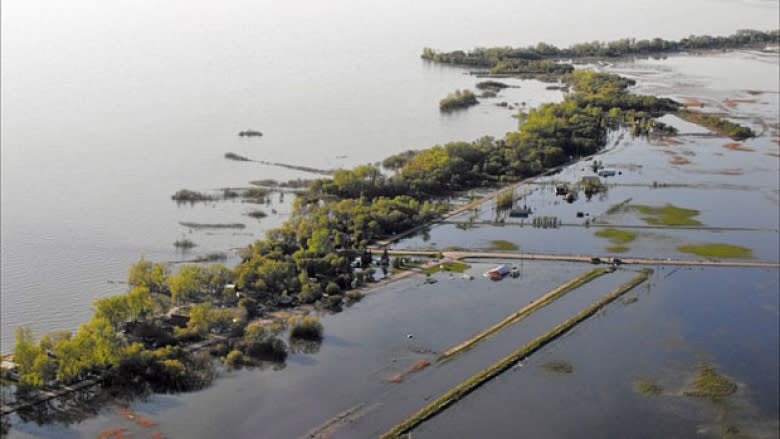Lake Manitoba property owners fighting for class-action suit over 2011 flooding

The waters of Lake Manitoba in front of Don Easton's home remain high, though not quite as high as they reached during the massive flood of 2011.
Six years later, Easton and several other Lake Manitoba property owners are fighting to launch a class-action lawsuit against the province.
In spring of 2011, powerful winds whipped up waves on the swollen lake, smashing into the shore and flooding properties along the south basin. Easton's home in Twin Lakes Beach escaped the flooding, but his boathouse was destroyed and many of his neighbours were forced to demolish their homes.
He says the province failed to properly compensate people for the flood, which he says was caused by the province diverting water from the Assiniboine River into the lake in order to protect properties downstream in Winnipeg.
"With the amount of water that was being put into the lake with the Portage Diversion, it was obvious to any of us who've had time out here that the day was going to come when we were going to be in big trouble," he said.
The property owners are seeking certification for a $260-million class-action lawsuit, but the lawyer representing owners says the province is challenging them, saying they should file lawsuits individually.
"It's tragic that six years later we're still fighting to get what we're entitled to and the government's now resisting that it's responsible," said Brian Meronek of DD West LLP.
Jack King's property in St. Laurent escaped the worst of the flooding, but it forced him and his wife out of their house for 14 months. King's wife underwent hip replacement during that time, and a relative wrecked his truck driving through deep water to retrieve King's belongings.
Although he's opted not to join the lawsuit, King agrees that many residents were not fairly compensated. He says the people employed by the province to assess the damage were "ill-equipped" and some had backgrounds assessing crop damage.
"They were not in a position to keep up with how catastrophic it turned out to be and the number of people they were dealing with, the claims, I think was overwhelming to them," King said.
Another class-action lawsuit involving nearby First Nations sets a precedent for his case, Meronek said. Earlier this year, flood evacuees from Lake St. Martin, Little Saskatchewan, Dauphin River and Pinaymootang First Nations settled for $90 million.
"So we thought, well, that's great. It's the same case. Different people, but it's all of the same arguments, the same facts. Well, the government decided in its wisdom that it would argue that it's different and here we are, back to square one, arguing."
Meronek said more than 100 property owners have joined the lawsuit.
Many compensation claims denied: lawyer
During the flood of 2011, the province operated the Portage Diversion — which reduces flooding on the Assiniboine River as it flows east past Portage la Prairie toward Winnipeg — for months.
Although property owners received some compensation for damaged property and other expenses, Meronek said there were many limits placed on the types and amounts of compensation they could receive and many claims were denied.
Easton isn't sure how much money he lost, but he described the province's attitude toward compensating people as "nonsense," saying the government should have admitted it was putting Lake Manitoba residents at risk in order to protect people downstream.
"They made a conscious decision, and probably the right decision, but they wouldn't just stand up and say it," he said. "I bet if they had said that and then followed through with some decent actions on it, they wouldn't be looking at a lawsuit."
A spokesperson for the province declined to comment for this story because the matter is before the courts.
Risk of flood remains
Since 2011, flood mitigation projects have been completed, offering property owners some protection, but the risk of another flood remains.
Fears of a flood rose again in 2014, and Easton worries about another flood in the spring.
"The lake being where it is right now, there's no room to put any more water in should we have a large runoff in the spring and the Assiniboine has to be diverted again, which wouldn't be a problem if we had a way of getting the water out."
The province plans to cut two new outlet channels on Lake Manitoba and Lake St. Martin to mitigate future floods. Channel construction is expected to start in 2019.


